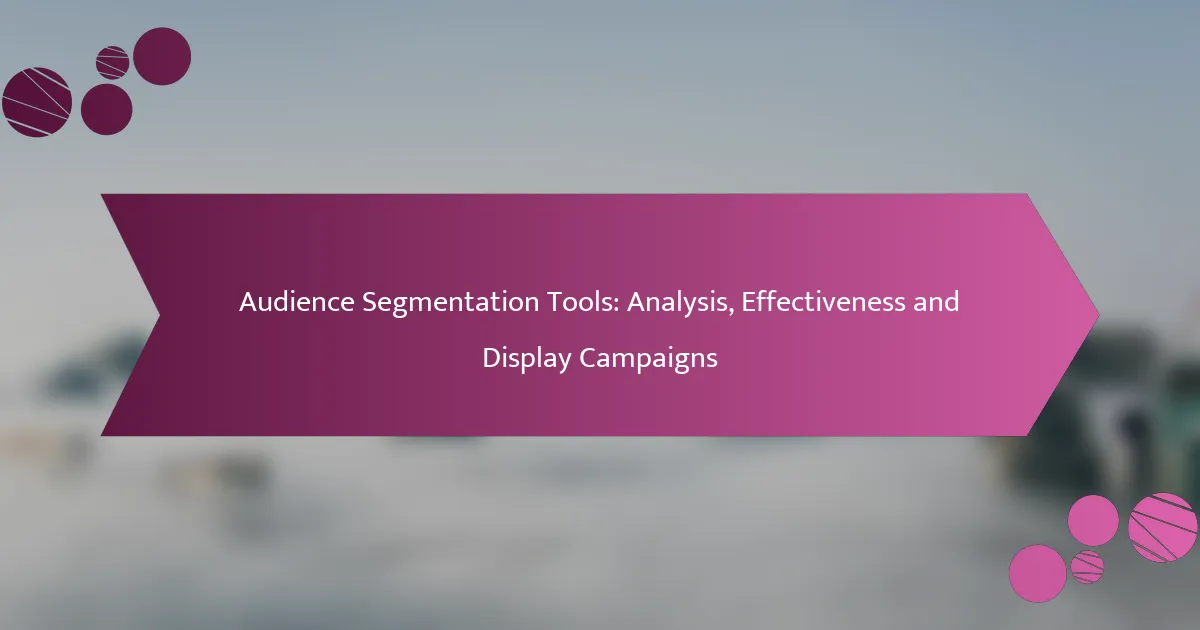Audience segmentation tools are essential for optimizing display advertising by enabling marketers to target specific demographics, interests, and behaviors. By tailoring campaigns to reach the most relevant audiences, these tools significantly enhance engagement and conversion rates, making marketing efforts more effective. When choosing the right tool, it’s important to consider factors such as integration capabilities, data privacy compliance, and cost-effectiveness to maximize value.

What are the best audience segmentation tools for display advertising?
The best audience segmentation tools for display advertising include platforms that allow marketers to effectively target specific groups based on demographics, interests, and behaviors. These tools enhance campaign performance by ensuring that ads reach the most relevant audiences, ultimately increasing engagement and conversion rates.
Google Ads Audience Insights
Google Ads Audience Insights provides detailed information about the audiences interacting with your ads. It allows advertisers to analyze demographic data, interests, and online behaviors, helping to refine targeting strategies. By leveraging this tool, marketers can create tailored campaigns that resonate with specific segments.
To utilize Google Ads Audience Insights effectively, start by exploring the audience reports to identify high-performing segments. Consider adjusting your bidding strategies based on the insights gained, focusing on demographics that show higher engagement rates.
Facebook Ads Audience Manager
Facebook Ads Audience Manager enables advertisers to create and manage custom audiences based on user data from Facebook and Instagram. This tool allows for precise targeting, including options for lookalike audiences, which help reach new users similar to existing customers. Utilizing this feature can significantly enhance ad relevance.
When using Facebook Ads Audience Manager, regularly update your audience lists to reflect changes in user behavior and preferences. Monitor campaign performance closely and be prepared to adjust targeting criteria to maximize effectiveness.
Segment
Segment is a customer data platform that centralizes user data from various sources, making it easier to create targeted audience segments for display advertising. By integrating data from different channels, Segment allows marketers to build a comprehensive view of their audience, leading to more informed targeting decisions.
To make the most of Segment, ensure that your data collection processes are robust and compliant with privacy regulations. Use the platform’s analytics features to identify trends and patterns that can inform your segmentation strategy.
HubSpot
HubSpot offers a suite of marketing tools, including audience segmentation features that help businesses target their display advertising effectively. With HubSpot, you can segment your audience based on various criteria, such as behavior, demographics, and engagement history, allowing for personalized marketing efforts.
For optimal results with HubSpot, regularly review and update your segmentation criteria to reflect changes in customer behavior. Leverage HubSpot’s reporting tools to analyze the effectiveness of your campaigns and refine your audience segments accordingly.

How do audience segmentation tools improve display campaign effectiveness?
Audience segmentation tools enhance display campaign effectiveness by allowing marketers to tailor their messaging to specific groups. This targeted approach increases engagement and conversion rates, making campaigns more efficient and impactful.
Enhanced targeting capabilities
Enhanced targeting capabilities enable marketers to identify and reach specific audience segments based on demographics, interests, and behaviors. By using data analytics, businesses can create highly personalized ads that resonate with different groups, leading to improved engagement.
For example, a retailer might segment their audience into categories like frequent buyers, seasonal shoppers, and first-time visitors. This allows them to craft unique messages for each group, maximizing the relevance of their display ads.
Increased ROI
Increased return on investment (ROI) is a significant benefit of using audience segmentation tools. By focusing resources on high-potential segments, marketers can reduce wasted ad spend and drive more conversions.
Studies suggest that targeted campaigns can yield ROI improvements in the range of 20-50%. This is achieved by ensuring that the right message reaches the right audience at the right time, ultimately leading to higher sales and lower customer acquisition costs.
Better customer insights
Better customer insights are gained through audience segmentation, allowing businesses to understand their customers’ preferences and behaviors more deeply. This knowledge can inform not only advertising strategies but also product development and customer service approaches.
For instance, analyzing data from segmented audiences can reveal trends in purchasing behavior, enabling companies to adjust their offerings or marketing strategies accordingly. Regularly updating these insights helps maintain relevance in a rapidly changing market.

What criteria should you consider when choosing an audience segmentation tool?
When selecting an audience segmentation tool, consider integration capabilities, data privacy compliance, and cost-effectiveness. These factors will significantly impact the tool’s usability, legal adherence, and overall value for your marketing efforts.
Integration with existing platforms
Choosing a segmentation tool that integrates seamlessly with your current marketing platforms is crucial. Look for tools that offer APIs or built-in connectors to popular CRM, email marketing, and analytics systems. This ensures that data flows smoothly between systems, enhancing efficiency and reducing manual work.
For example, if you use Salesforce for customer relationship management, a tool that easily connects with Salesforce can help you segment your audience based on real-time data. This integration can lead to more targeted campaigns and better performance.
Data privacy compliance
Data privacy compliance is essential when selecting an audience segmentation tool, especially in regions with strict regulations like the EU’s GDPR or California’s CCPA. Ensure that the tool adheres to these regulations to protect user data and avoid potential fines.
Check if the tool provides features such as data encryption, user consent management, and options for data anonymization. These features not only help in compliance but also build trust with your audience.
Cost-effectiveness
Cost-effectiveness is a key consideration when evaluating audience segmentation tools. Compare pricing models, which may include subscription fees, pay-per-use, or tiered pricing based on features. Assess what you need and find a tool that offers the best value for those specific requirements.
For instance, if your business is small, look for tools that offer basic segmentation features at a lower price point. Conversely, larger enterprises might benefit from more advanced features, justifying a higher investment. Always weigh the potential return on investment against the costs involved.

How can you analyze audience segmentation data?
Analyzing audience segmentation data involves examining the characteristics and behaviors of different groups within your audience to tailor marketing efforts effectively. This process can enhance targeting strategies and improve overall campaign performance.
Using analytics dashboards
Analytics dashboards provide a visual representation of audience segmentation data, allowing marketers to quickly assess performance metrics. Tools like Google Analytics or Adobe Analytics can display user demographics, engagement rates, and conversion statistics in real-time.
When using dashboards, focus on key performance indicators (KPIs) such as click-through rates and bounce rates. Regularly reviewing these metrics helps identify which segments are performing well and which may need adjustment.
Conducting A/B testing
A/B testing allows you to compare two versions of a campaign to see which performs better among specific audience segments. By changing one variable at a time, such as subject lines or ad placements, you can gather data on user preferences and behaviors.
To implement A/B testing effectively, ensure you have a sufficient sample size for statistically significant results. Aim for a testing period of at least one to two weeks to account for variations in user behavior across different days.
Leveraging customer feedback
Customer feedback is invaluable for understanding audience segmentation. Surveys, reviews, and direct interactions can provide insights into customer preferences and pain points, helping refine your segmentation strategy.
Utilize tools like SurveyMonkey or Typeform to gather structured feedback. Consider asking targeted questions that relate to specific segments, which can guide future marketing efforts and improve customer satisfaction.

What are the common challenges in audience segmentation for display campaigns?
Audience segmentation for display campaigns often faces challenges that can hinder effectiveness. Key issues include data quality, the risk of over-segmentation, and the impact of changing consumer behavior.
Data quality issues
Poor data quality can significantly affect audience segmentation outcomes. Inaccurate, outdated, or incomplete data leads to misguided targeting, resulting in wasted ad spend and missed opportunities. Regularly auditing and cleaning data sources is essential to maintain accuracy.
To improve data quality, consider implementing robust data validation processes and using reliable third-party data providers. This ensures that the information used for segmentation is both current and relevant, enhancing the overall effectiveness of display campaigns.
Over-segmentation risks
Over-segmentation occurs when audiences are divided into excessively narrow groups, which can dilute the impact of marketing efforts. This fragmentation may lead to smaller audience sizes, making it difficult to achieve significant reach or engagement. Striking a balance between targeted and broad segments is crucial.
To avoid over-segmentation, focus on creating a manageable number of segments that still capture key differences in consumer behavior. Testing and refining segments based on performance data can help maintain effectiveness without losing sight of broader audience trends.
Changing consumer behavior
Consumer behavior is dynamic and can change rapidly due to various factors, including economic conditions, cultural shifts, and technological advancements. These changes can render existing audience segments less effective or even obsolete. Staying attuned to these shifts is vital for maintaining relevant targeting strategies.
To adapt to changing consumer behavior, regularly analyze engagement metrics and feedback from campaigns. Utilizing real-time analytics tools can help identify trends and inform adjustments to segmentation strategies, ensuring that campaigns remain aligned with current consumer preferences.

How do different industries utilize audience segmentation tools?
Different industries leverage audience segmentation tools to tailor their marketing strategies effectively. By analyzing customer data, businesses can create targeted campaigns that resonate with specific groups, enhancing engagement and conversion rates.
Retail industry strategies
The retail industry employs audience segmentation tools to identify distinct customer groups based on purchasing behavior, demographics, and preferences. For instance, a clothing retailer might segment its audience into categories like age, gender, and style preferences to personalize marketing messages and promotions.
Retailers often use data analytics to track customer interactions and sales trends, allowing them to adjust inventory and marketing strategies accordingly. This targeted approach can lead to increased customer loyalty and higher sales, especially during seasonal promotions.
Healthcare marketing approaches
In healthcare, audience segmentation tools help providers tailor their messaging to different patient demographics, such as age, health conditions, and geographic location. For example, a hospital might segment its audience to promote specific services like pediatrics or geriatrics, ensuring that the right information reaches the right patients.
Healthcare marketers can utilize segmentation to address unique patient needs, improving patient engagement and satisfaction. By focusing on specific health concerns or local health trends, healthcare organizations can create more effective outreach campaigns that resonate with their target audience.









